India: Notes from the Struggle in the Narmada Valley Special Report
New in Ceasefire, Special Reports - Posted on Tuesday, October 8, 2013 10:57 - 2 Comments
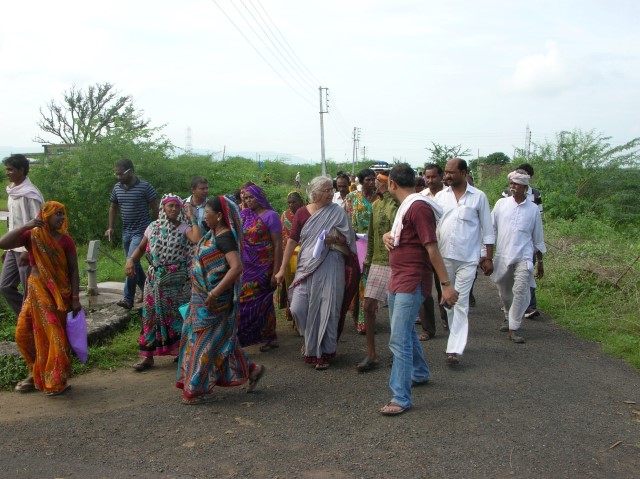
Walk to successfully gained land-for-land rehabilitation site at Kargat, Madhya Pradesh
In the Narmada Valley, the struggle continues
Heavy police presence was in place in the villages from the night before the planned demonstration. In the early morning of September 1st, villagers assembled for jal satyagraha protests, entering the flood waters up to their necks and vowing to stay there indefinitely. State anxiety at negative pre-election publicity led to a heavy police response. Reinforcements were called and hundreds of villagers were arrested.
The jal satyagraha protests and subsequent arrests in Dewas, Hardwa and Khandwa districts of Madhya Pradesh this month were only the latest clash in a struggle that is perhaps post-Independence India’s longest running environmental and social movement. Protesters are angry about the flooding of their homes, land and crops by the Indira Sagar dam which they say is only to produce electricity for Gujarat.
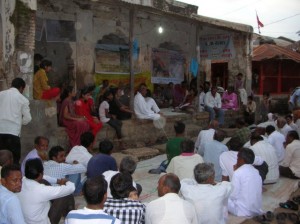
Meeting in village due to be submerged
The protests have precedent. Last year a similar indefinite demonstration by villagers affected by the Omkareshwar dam ended after 17 days when the government agreed to limit the dam height. In May this year a two billion rupee (£20million) rehabilitation package for the dam was agreed.
With India’s monsoons seeming to arrive later, more irregularly, and with greater intensity, concerns about flooding are well founded. In August this year the Narmada river rose 18 feet above the danger level flooding 24 of the 50 districts in Madhya Pradesh and forcing at least 5,000 people to be relocated to safer areas. I met one couple whose entire house had been swept away by flooding and many more whose land and crops had been damaged.
As pre-election debate in India about Narandra Modi and the ‘Gujarat development model’ continues in the run-up to 2014 national elections, the people here continue to demand answers about the production of water and power for Gujarati cities and industries.
The Dams
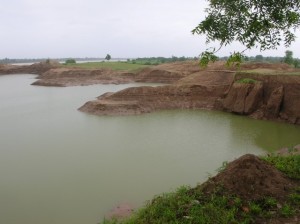
Sand mining site
The Narmada is India’s second longest river, flowing from eastern Madhya Pradesh to the Arabian sea at Gujarat through some of India’s most fertile land. Much of the area is occupied by adivasi (tribal) people, 750 million of whom live in the hill regions of central India. At full height, the Sardar Sarovar Dam will submerge some 200km sq, affecting 250,000 people and 242 villages (33 in Maharashtra, 190 in Madhya Pradesh, 19 in Gujarat). The reservoir for the Indira Sagar dam will be the largest in India and the second largest in Asia, displacing 300,000 people.
First raised as a possibility in 1946, the year before independence, planning for big dams on the Narmada began under Prime Minister Nehru in the 1960s and only started during the 1970s. The Narmada Valley Development Project proposes the construction of 30 big dams, 135 medium dams and 3000 smaller dams on the river. Projects are currently underway on the river intended to provide water and power to Madhya Pradesh, Maharashtra, and primarily, Gujarat, particularly the drought-prone regions of Saurashtra and Kutch.
Dams block the flow of the river to generate power and reroute water to alternate destinations. Dams constrict water flow creating a reservoir in the area behind the dam. This submerges large areas of land next to the river and floods much more, particularly during heavy rains. This ‘backwater’ area becomes increasingly silted over the lifetime of the dam, eventually reaching a point where the dam ceases to operate effectively. In the case of the big dams on the Narmada the backwater extends through some 150km of fertile plains in Madhya Pradesh.
Unfortunately, dam projects appear to serve the powerful to the detriment of the poor behind the dam in Gujarat in the same way they did for those in Madhya Pradesh and Maharashtra. Water and power are reaching the affluent Gujarati cities, but in 18 years only 15% of the 80,000 km irrigation canal network has been completed, making it impossible for irrigation water to reach draught-prone Saurashtra and Kutch.
Although the project has been justified in the name of poor farmers it seems to be displacing them on both sides of the dams. Farmers in Mandal and Detroj districts of Gujarat who have been waiting 30 years for Narmada water have now been told that 2922.68 ha of their land will be acquired for a Maruti Suzuki car plant. In the Baruch and Vagra districts, farmers have been told that 14,927 ha of their land in the dam command area will be acquired for a petro-chemical Special Investment Region (SIR). The demands for SIR land in the command area have been increasing as has the allocation of land to industry in Kutch. Compensation for land acquired and damaged by the Narmada Valley project is a continuing source of controversy. Corruption cases of up to 1,000 crore rupees (£100 million) are under judicial review. This includes: 3,000 fake names on the rehabilitation list, land allocation funding spent but no land provided, inadequate land and construction at rehabilitation sites, and compensation allocated to ineligible people and non-existent buildings.
The Movement
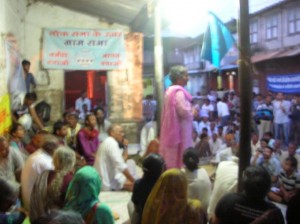
Meeting in affected village
The battle over land and displacement is now a central part of the struggle in the Narmada. Although the campaign led to both the World Bank and the Indian government introducing resettlement and rehabilitation standards for development projects, forcing the central and state government to honour their provisions is a continuing challenge.
With good timing and persistence, protests are successful. In Kalgat, village farmers have got land from the Madhya Pradesh government in the first land-for-land rehabilitation of its size in the state. The 21 adivasi families displaced from Pichwari, Badal and other places have been fighting for fair rehabilitation for 30 years. Sadly, they are the exception. In Madhya Pradesh most people have used the cash compensation scheme. This has created large issues around corruption. Many families have refused the promise of inadequate cash compensation on offer and thousands of people who have been fighting for years for an adequate rehabilitation are supporting the andolan. The insistence on land-for-land is reflected in the chant: “Zamin nahi toh, bund nahi toh” – No land, no dam!
In this situation, some families who have grown tired of seeing the slow progress of government action have simply occupied land to farm. Thirty acres of Madhya Pradesh state government land has been occupied since 2011. People displaced by dams on the Narmada are cultivating it. These occupiers are landless people from oppressed castes and tribes. In 2007, a previous land occupation by displaced people was violently evicted by police baton charges after a month. A case was brought against the police at the State’s High Court, and the police were ordered to pay compensation. Consequently the Madhya Pradesh government are now ‘more cautious’ in their handling of the occupation. According to the law, the height of the dam can only be raised if all rehabilitation is completed. And yet, although officials claim such rehabilitation has been completed, many people are protesting that they have not been rehabilitated or they have been offered land unfit for cultivation. This discrepancy between the reality and the paperwork is something the state governments may not like to be examined in court.
In the areas due for submergence, in addition to the ending of government services for local adivasi people, because ‘on paper’ no-one is living there, illegal sand mining of the riverbed has recently come up as an issue. Sand is a key ingredient for concrete, and sand from the Narmada goes to fuel construction booms in Indore, Mumbai and Delhi.
Dams already cause a problem with siltation of river flows leading to loss of animal and plant life, decreased water quality, reduced navigability and greater risk of flooding. The drainage catchment area is supposed to be treated to reduce siltation by collecting deposits. However, removal of river bank and riverbed sand in this area does exactly the opposite.
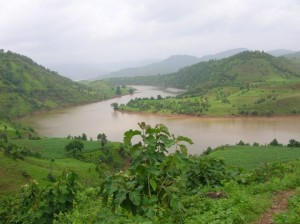
View of the bloated river
Tired of the lack of action, local NBA activists came down to the sand mining site one night and surrounded the trucks. The workers ran away, but the supervisors stayed. The activists called the police, who eventually and unwillingly came and were made to arrest the supervisors. NBA members have been accosted at their homes and received death threats in response to the action. The mining supervisors were sent to jail, but when the case came up in court the judge ruled that some important documents were not admissible because they were written in Hindi. NBA has filed a case in the Jabalpur court for illegal mining of sand which names about 10 firms as owners of the trucks.
At the national level, the ‘sand mafia’ has been attracting a lot of attention since the suspension (and recent reinstatement) of Durga Shakti, a government officer who clamped down on the ‘sand mafia’ in Uttar Pradesh. Illegal sand mining on the Narmada has yet to attract the same level of attention but the ecological damage, and powerful interests involved, are similarly hard to address.
The movement in the Narmada valley is exceptionally long-lived and draws support from dedicated and charismatic leadership, a network of local organisers, and wide and affectionate social support. Their home-grown mix of radical ecology, social justice and non-violent protest is uncompromising and not uncontroversial. Over the years, an intensely well-documented and reasoned approach, using legal advocacy as much as activism, has contributed to the respect that many hold them in.
To learn more about the Narmada you could take a look at these articles by Ramanchandra Guha, Arundhati Roy and Amita Baviskar.
2 Comments
Notes from the Struggle in the Narmada Valley | Human+ Geography
Notes from the Struggle in the Narmada Valley | Idler on a hammock
[…] via India: Notes from the Struggle in the Narmada Valley | Ceasefire Magazine. […]



[…] Some writing about my recent visit to the Narmada Valley https://ceasefiremagazine.co.uk/notes-struggle-narmada-valley-india/ … […]